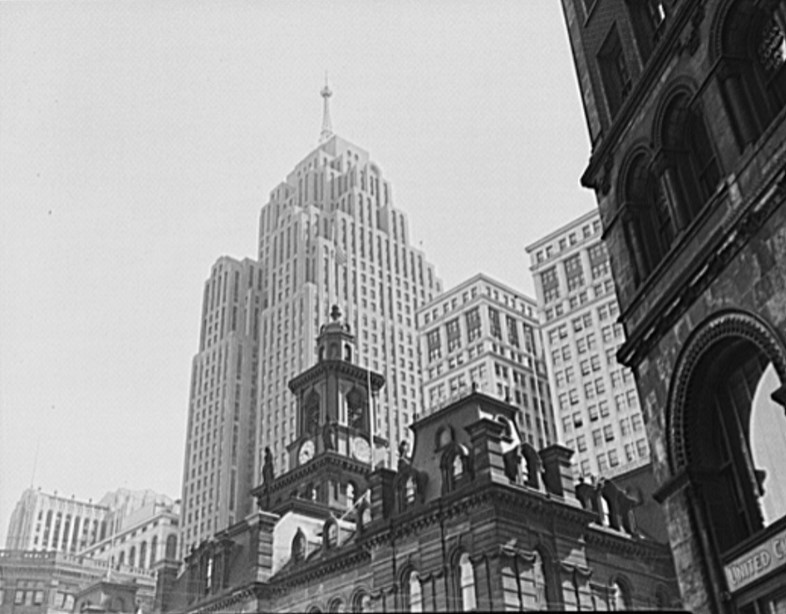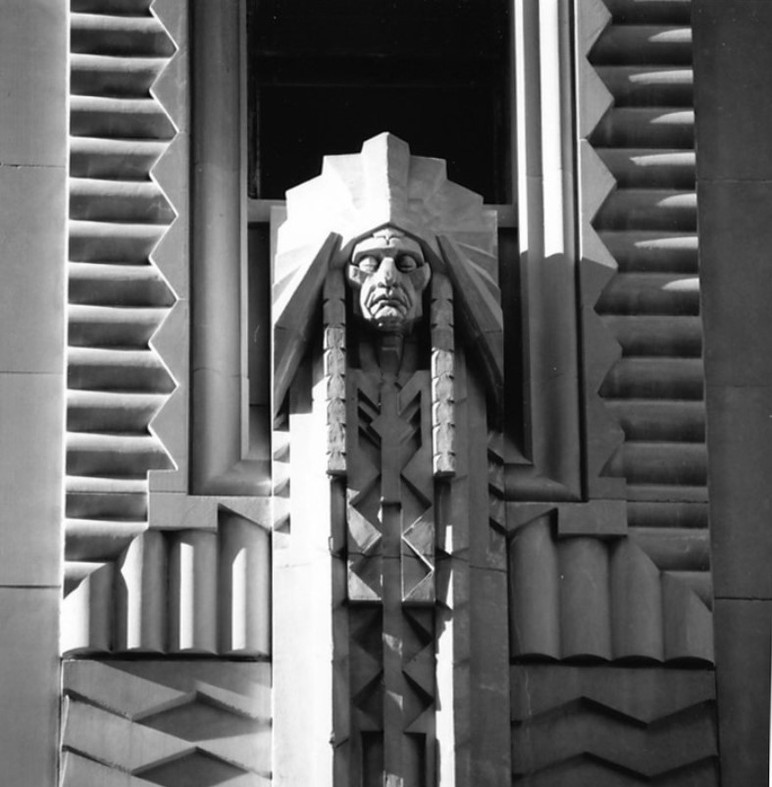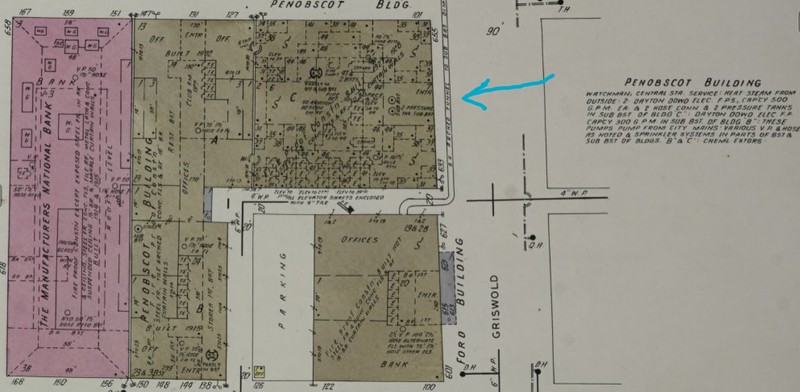Greater Penobscot Building
Introduction
Text-to-speech Audio
This 47-story limestone Art Deco skyscraper was designed by architect Wirt Clinton Rowland (1878-1946) and completed in 1928. Named for a Native American tribe from Maine, the building features carvings by Italian sculptor Corrado Parducci. Currently the third-tallest building in Detroit, the Greater Penobscot Building was the tallest in Detroit from 1928 to 1977 (when the Renaissance Center was built). The Greater Penobscot Building is part of the National Register Detroit Financial Historic District. The district, containing mainly Art Deco and Classical Revival style skyscrapers dating to the early-to-mid twentieth century, is bounded by Woodward, Jefferson, Lafayette, and Washington Boulevard and was listed in 2009.
Images
Greater Penobscot Building in 2007 photo (Balthazar Korab Studios Ltd.)

Greater Penobscot Building in background behind top of Detroit City Hall in 1942 photo (Arthur S. Siegal)

Sculptural detail of a Penobscot Indian on the building's facade (Einarsson Kvaran 2006)

Greater Penobscot Building (arrow points to entrance) on 1950 Sanborn Map (Sanborn Map Company p. 5)

Backstory and Context
Text-to-speech Audio
The Murphy Company was behind the construction of three Penobscot Buildings in downtown Detroit, the largest of which, the Greater Penobscot Building, was designed by Wirt Rowland of Smith, Hichman &Grylls from 1926 to 1927. The name Penobscot was chosen by the Murphy family patriarch, Simon Sr., who got his start in his successful logging career near the Penobscot River in Maine (named after a local Native American tribe). The excavation of the building's deep foundation supports resulted in the deaths of two workers,. The building ended up costing about five million dollars to build but was competed in a year.
The Greater Penobscot Building took the spot where the Moffat Building previously stood - a 6-story tall brick building with a stone facade along the two street sides. The Greater Penobscot Building was constructed from 1927 to 1928, next door to an earlier Penobscot Building to the west that was built in two stages in 1902 and 1915. Some say that the Greater Penobscot Building's Art Deco style of setbacks on the upper floors inspired the design of the iconic Empire State Building in Manhattan.
Although the sometimes-blinking illuminated red globe at the pinnacle of the 565-foot building was rumored to have been a docking spot for dirigible aircraft, the red light served as a general aviation beacon and decoration. The 12-foot-wide orb is visible from 40 miles away. The top of the building's observation deck was put into use in May 1942 during the second planned Blackout drill in the region during World War II. Civilian defense officials viewed the city from the observation deck; sirens wailed for three minutes before the 10 p.m. deadline and cars pulled off to the sides of roads. The city's street lights were turned off at 10:05 and the town was dark, for the most part; factories involved in the war effort were given permission to keep their lights on to keep working during the drill. The owner reportedly may reopen the observation deck below the glowing red orb someday.
For a time in the 1970s and 1980s, the building was renamed the City National Bank Building for its major tenant. Triple Properties of Toronto, Ontario, Canada purchased the Greater Penobscot building in 2012 for five million dollars. The Caucus Club, a steak restaurant, reopened in the building in 2017 after renovations; it had previously been open there from 1952 to 2012. The building's long-time second-largest tenant, Strategic Staffing Solutions, occupied three floors of the building until moving to another skyscraper in 2019.
Sources
Anonymous. "Blackout 'Just Fair' Jeffries Declares." Detroit Evening News (Detroit, MI) May 25th 1942. Night ed, 1-4.
Beshouri, Paul. Penobscot Building ponders reopening observation deck, Curbed Detroit. January 28th 2015. Accessed July 30th 2021. https://detroit.curbed.com/2015/1/28/9997868/penobscot-building-ponders-reopening-observation-deck.
Carlson, Dale. The Penobscot Building - Detroit, Michigan, I Love Detroit Michigan. March 23rd 2012. Accessed August 2nd 2021. https://www.ilovedetroitmichigan.com/detroit-architecture/the-penobscot-building-detroit-michigan/?show=gallery.
Mondry, Aaron. Strategic Staffing Solutions moves offices from Penobscot to Fisher Building, Detroit Curbed. October 17th 2019. Accessed July 29th 2021. https://detroit.curbed.com/2019/10/17/20919681/strategic-staffing-solutions-fisher-building-new-center.
Nailhed. Roofing the Penobscot, Nailhed. Blog. January 1st 2014. Accessed July 30th 2021. https://www.nailhed.com/2014/01/penobgobble.html.
National Park Service. Asset Metadata, Detroit Financial District, National Register Digital Assets. Accessed August 2nd 2021. https://npgallery.nps.gov/AssetDetail/NRIS/09001067.
Runyan, Robin. Is the red orb lit up at the Penobscot Building for good?, Curbed Detroit. May 15th 2017. Accessed July 30th 2021. https://detroit.curbed.com/2017/5/15/15642324/penobscot-building-red-orb.
Runyan, Robin. Mondry, Aaron. Detroit's most iconic buildings, mapped, Curbed Detroit. November 4th 2019. Accessed July 29th 2021. https://detroit.curbed.com/maps/most-iconic-greatest-buildings-detroit.
Sanborn Map Company. Sanborn Fire Insurance Map from Detroit, Wayne County, Michigan. Volume 1. New York, NY. Sanborn Map Company, 1921.
Winchester, Hank. Hutchinson, Derick. Tenants fed up with broken elevators inside Detroit's Penobscot Building, Click On Detroit. September 30th 2019. Accessed July 29th 2021. https://www.clickondetroit.com/2019/09/30/tenants-fed-up-with-broken-elevators-inside-detroits-penobscot-building/.
Balthazar Korab Collection: https://www.loc.gov/item/2020714751/
Farm Security Administration Office of War Information Photographic Collection: https://www.loc.gov/item/2017826200/
https://en.wikipedia.org/wiki/Penobscot_Building#/media/File:PenobscotIndian1.jpg
https://www.loc.gov/item/sanborn03985_050/
